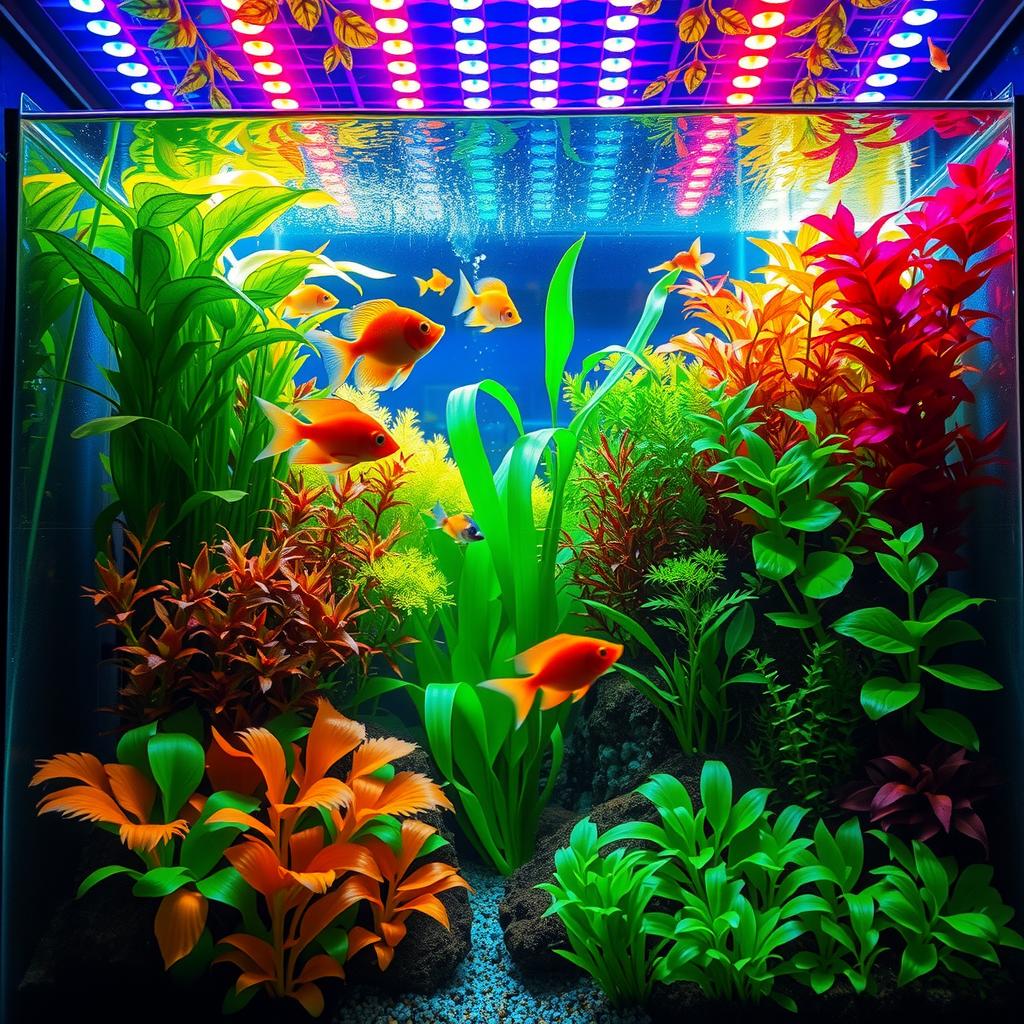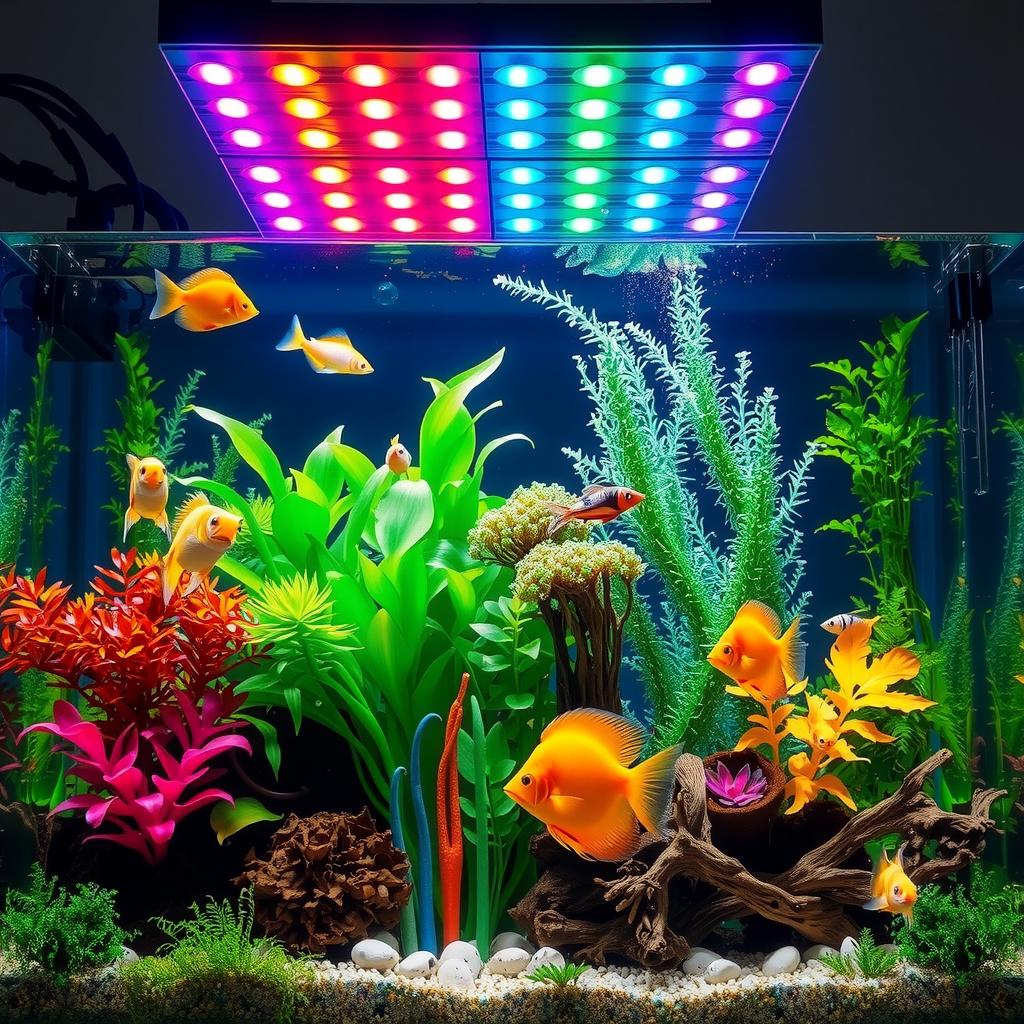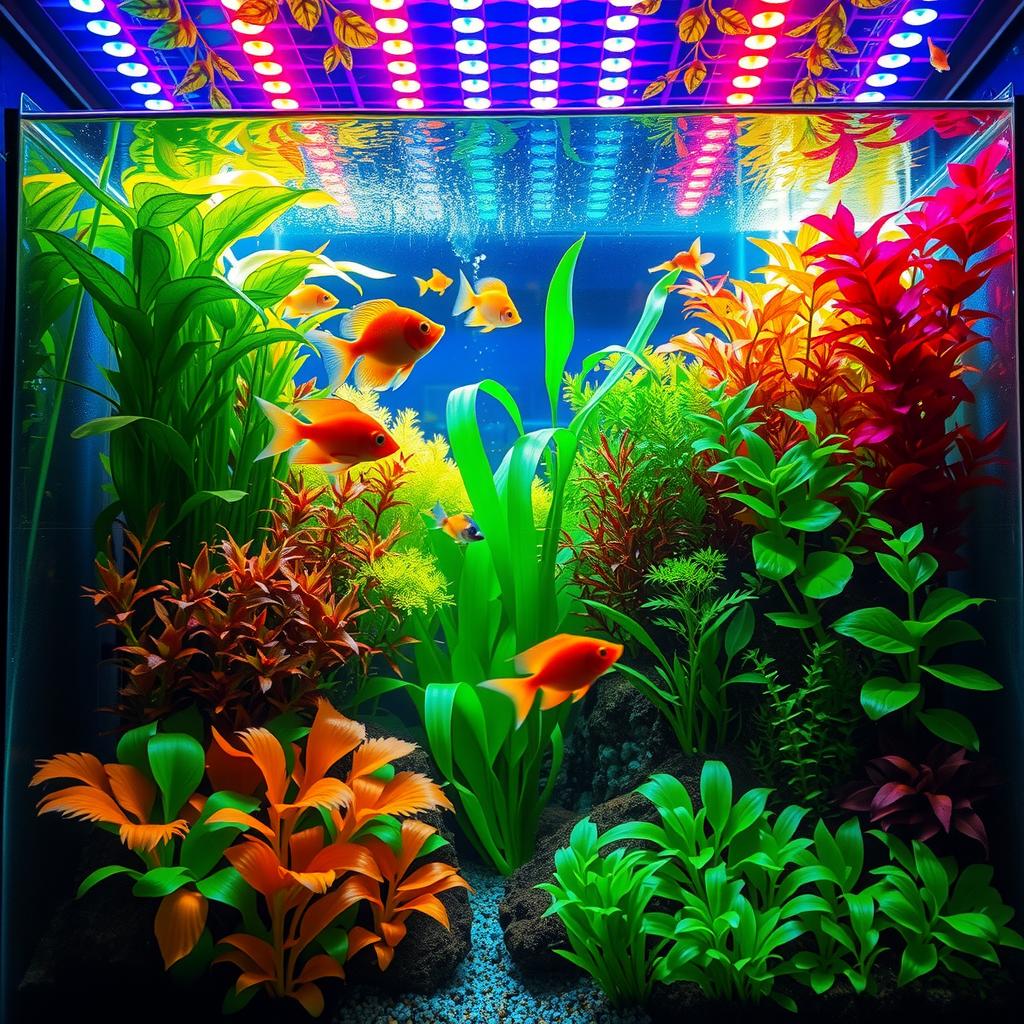Have you ever marveled at a thriving underwater garden, bursting with vibrant colors and lush foliage? The secret to achieving such beauty lies in the right LED aquarium lighting system. As indoor gardening gains popularity, the challenge many face is how to create an optimal environment for live plants that not only enhances the aesthetic appeal of their aquariums but also supports robust plant growth. With so many options available, understanding which lighting solutions work best for aquatic plants can be overwhelming.
This article delves into the transformative power of an LED aquarium lighting system, showcasing its core value in promoting healthy plant growth. Unlike traditional fluorescent or incandescent lights, LED technology offers a spectrum of light that can be tailored specifically for various types of aquatic flora. This optimized lighting not only provides essential wavelengths necessary for photosynthesis but also ensures energy efficiency—a crucial factor for both sustainability and cost-effectiveness.
By exploring how these specialized aquarium lights contribute to healthier ecosystems within fish tanks, readers will uncover practical insights into selecting the most suitable products based on specific needs. Whether one is nurturing delicate ferns or hardy Java moss, this guide emphasizes that adopting an effective lighting system is pivotal to success in cultivating live plants beneath water’s surface.
As we navigate through this topic, it becomes clear that addressing common challenges like algae overgrowth or insufficient light penetration requires thoughtful consideration of one’s chosen equipment. The potential benefits are remarkable: from enhanced aesthetics and improved water quality to fostering biodiversity among aquatic life—all achievable through a well-implemented LED aquarium lighting system.
Join us as we provide valuable tips and guidance on maximizing your indoor gardening efforts with cutting-edge technology designed explicitly for plant health—because when it comes to creating a stunning underwater landscape, every detail counts!

Key Points:
-
Optimal Lighting for Plant Growth: The Role of LED Technology
A well-designed LED aquarium lighting system is essential for fostering healthy and robust aquatic plants. Unlike conventional bulbs, modern aquarium lights utilize energy-efficient LED technology that targets specific wavelengths to enhance photosynthesis. This tailored approach not only mimics natural sunlight but also promotes vigorous growth in live plants, making it a crucial factor for any indoor gardening enthusiast aiming to create a flourishing underwater environment. -
Understanding Lighting Schedules: Impact on Aquatic Flora
Establishing the right lighting schedule plays a pivotal role in plant health within an aquarium setting. By implementing an effective lighting system, hobbyists can observe significant improvements in the vitality and aesthetics of their aquatic plants. Different types of bulbs and varying light durations can influence leaf structure and coloration, underscoring the necessity of choosing an appropriate LED aquarium lighting system that aligns with the specific needs of diverse plant species. -
Creating a Balanced Ecosystem: Benefits Beyond Aesthetics
Investing in quality LED lighting solutions extends beyond visual appeal; it fosters a balanced ecosystem where both flora and fauna thrive together harmoniously. With optimized lighting tailored for their unique environments, users will find themselves equipped with reliable growth solutions that significantly enhance plant development while ensuring sustainability within their aquariums. Selecting suitable products from advanced aquarium lights options ensures that both beauty and ecological balance are achieved effortlessly.

Understanding LED Aquarium Lighting
The Essential Role of Optimized Lighting for Aquatic Plants
The significance of an optimized LED aquarium lighting system cannot be overstated when it comes to fostering a healthy environment for aquatic plants. In any aquarium setup, the quality and intensity of light play crucial roles in supporting plant growth and overall ecosystem health. Unlike traditional incandescent or fluorescent lights, modern LED lighting offers tailored wavelengths that promote photosynthesis more effectively. By utilizing specific spectrums that are beneficial to different types of aquatic flora, aquarium enthusiasts can create conditions conducive to vibrant plant life.
For instance, live plants such as Anubias or Java Fern thrive under red and blue spectra provided by advanced aquarium lights, which stimulate their natural growth processes. This targeted approach ensures that each species receives the necessary light spectrum they require for optimal development. Moreover, using an optimized lighting system can significantly enhance the aesthetic appeal of aquariums, bringing out the vivid colors in both plants and fish alike while reducing energy consumption compared to other lighting options.
Furthermore, understanding how much light is required over a given period is vital for establishing a balanced ecosystem within the tank. Too little light can lead to poor plant health and stunted growth while excessive exposure may result in algae blooms threatening the delicate equilibrium between various organisms present in the water body. Therefore, setting up timers with your chosen LED aquarium lighting system allows hobbyists to simulate natural daylight cycles efficiently—this promotes not only healthier aquatic plants but also benefits fish by mimicking their native habitats.
In addition to promoting growth solutions through effective illumination strategies, incorporating features such as dimmable settings enhances flexibility for varying plant species’ needs throughout different stages of their lifecycle. Whether one aims at growing lush foreground carpets or towering background plants like Vallisneria, having control over brightness levels becomes indispensable when managing diverse underwater landscapes.
Moreover, investing in high-quality LED technology has long-term cost benefits due to its durability and lower energy costs compared with conventional bulbs; this translates into reduced operational expenses without compromising on results achieved from top-tier products available today—in particular the LED aquarium lighting system. Such systems often come equipped with features designed specifically for indoor gardening applications ensuring user-friendly experiences regardless if one is just starting out or refining expertise over time.
Ultimately integrating an efficient lighting system into any aquarist’s toolkit lays down foundational elements essential not only for thriving aquatic environments but also encourages responsible practices among hobbyists passionate about nurturing nature’s beauty right within their homes.
Understanding Different Types of LED Bulbs
The Foundation of Optimal Plant Growth
Choosing the right type of LED bulbs is crucial for achieving optimal growth in aquatic plants. The LED aquarium lighting system offers a variety of bulb types, each designed to meet specific needs for different plant species. Full-spectrum LEDs are particularly beneficial as they emit light across all wavelengths, supporting photosynthesis effectively. This type allows indoor gardeners to replicate natural sunlight conditions, which is vital for healthy plant growth. In contrast, grow lights with specific color spectrums can be tailored to promote certain aspects of plant health; blue light encourages vegetative growth while red light aids flowering and fruiting processes. Additionally, the wattage and intensity of these bulbs play a significant role in determining how well plants will thrive under artificial conditions. Therefore, selecting appropriate aquarium lights based on both the biological demands of live plants and the environmental factors within an aquarium setup is essential.
Wavelengths: The Science Behind Light Spectra
Optimizing Light Conditions for Aquatic Plants
The wavelengths emitted by different LED setups have profound implications on plant health and development within an aquarium environment. Research has shown that various colors in the light spectrum affect photosynthesis rates differently among aquatic flora; thus understanding this can lead to more effective use of an LED aquarium lighting system. For instance, ultraviolet (UV) light can enhance pigmentation in some species while infrared (IR) may stimulate root development indirectly through heat generation without causing stress due to excessive brightness or heat from direct exposure. Furthermore, maintaining balanced wavelengths ensures that all stages of growth—from germination through flowering—are adequately supported by your chosen lighting solution. Indoor gardening enthusiasts should also pay attention to how these spectra interact with water parameters such as clarity and chemistry since they can alter light penetration significantly within deeper tanks.
Lighting Schedules: Timing Is Everything
Crafting a Sustainable Routine
Establishing appropriate lighting schedules is another critical factor when utilizing any LED aquarium lighting system aimed at fostering robust aquatic plant life. Research indicates that most aquatic plants benefit from around 10-12 hours of consistent illumination per day followed by equal periods of darkness—this mimics their natural habitat’s cyclical patterns necessary for metabolic processes like respiration and nutrient uptake during nighttime hours when photosynthesis ceases due to lack thereof sunlight exposure . However, variables including tank depth or presence/absence thereof floating debris might necessitate adjustments over time based upon observed results regarding overall health status amongst live plants present in your installation . Adopting programmable timers not only simplifies adherence but allows precise control over daily routines enhancing reliability whilst eliminating human error often associated with manual operations ensuring favorable outcomes consistently throughout seasonal variations .
Evaluating Your Setup: Regular Monitoring Matters
Ensuring Long-Term Success
To maintain optimal growth conditions using an LED aquarium lighting system, regular evaluation becomes paramount after initial setup completion phases conclude successfully yielding desired results towards promoting vibrant underwater ecosystems populated primarily by flourishing live plants thriving happily alongside fish inhabitants sharing same space harmoniously together! Factors such as bulb lifespan longevity must be tracked diligently noting especially signs pertaining diminishing intensity levels indicating need replacement timely avoiding potential setbacks leading backward progression instead forward advancement should always remain goal-driven focus ultimately aiming achieve ideal balance between aesthetics practicality heightening experience witnessed enjoying lush greenery accompanied captivating wildlife residing therein! Thus ongoing vigilance encompassing routine assessments help ensure lasting success guaranteeing longevity support dynamic interactions occurring naturally enhanced visually appealing environments resonate joyfully lives shared amidst enchanting displays showcasing nature’s beautiful synergy created effortlessly achieved simply through intelligent design choices made wisely beforehand!
Creating a Harmonious Underwater Habitat
Merging Aesthetics with Sustainability in Aquatic Environments
In the quest for an aesthetically pleasing underwater environment, the importance of sustainability cannot be overstated. The integration of high-quality LED aquarium lighting systems plays a pivotal role in achieving this balance. These advanced lighting solutions not only enhance visual appeal but also provide optimal conditions for both aquatic plants and animals to thrive. By mimicking natural light spectrums, LED lights promote healthy plant growth, ensuring that live plants flourish while simultaneously creating a vibrant ecosystem for fish and other aquatic creatures. The energy efficiency of these systems reduces carbon footprints, making them an environmentally friendly option that aligns with sustainable practices in indoor gardening.
Furthermore, investing in quality LED aquarium lighting can significantly impact the overall health of an aquarium’s inhabitants. Proper illumination encourages photosynthesis among aquatic plants—essentially feeding them and helping maintain water quality through oxygen production. This is where the synergy between aesthetics and ecology shines; when plants are thriving under optimized lighting conditions provided by your lighting system, they create lush habitats that offer shelter and food sources for various species of fish and invertebrates. This interconnectedness fosters biodiversity within aquariums, proving that beauty need not come at the expense of ecological responsibility.
Optimizing Growth Solutions for Aquatic Flora
Enhancing Plant Health Through Innovative Lighting Technology
The evolution of technology has ushered in innovative solutions like the LED aquarium lighting system, which has revolutionized how hobbyists approach their aquariums’ environments. Unlike traditional incandescent or fluorescent bulbs, LED lights emit less heat while delivering targeted wavelengths essential for plant growth—a crucial factor when selecting appropriate aquarium lights. With adjustable settings available on many modern systems, users can tailor light intensity to suit specific types of aquatic plants ranging from hardy low-light varieties to more demanding species needing intense illumination.
Moreover, research indicates that certain colors within light spectra play significant roles in stimulating different aspects of plant growth; blue light promotes vegetative development while red light supports flowering processes—an exciting prospect for enthusiasts looking to cultivate diverse ecosystems. By implementing such tailored strategies using well-designed lighting systems, aquarists can ensure their underwater gardens remain vibrant and resilient against pests or diseases often associated with poor growing conditions.
This thoughtful approach does not merely benefit flora but extends its advantages toward fauna as well—the aesthetic allure created by flourishing greenery enhances viewer experience while providing necessary hiding spots essential for stress reduction among fish populations. In fostering such balanced interactions between flora and fauna through effective use of LED technology, individuals contribute positively towards achieving a harmonious coexistence within their aquariums—where every component thrives together sustainably yet beautifully.
Frequently Asked Questions:
Q: How does a LED aquarium lighting system enhance plant growth?
A: A well-designed LED lighting setup provides specific wavelengths of light that are essential for photosynthesis, thus promoting vigorous growth among aquatic plants. The energy-efficient nature of these systems also mimics natural sunlight conditions, making them an effective solution for indoor gardening.
Q: What types of aquatic plants benefit most from optimized LED lighting?
A: Most aquatic plants thrive under the right conditions provided by a quality aquarium lights solution. Species like Anubias, Java Fern, and Amazon Sword can particularly flourish when exposed to optimal light levels offered by a suitable lighting system designed for their specific needs.
Q: How can I determine the ideal lighting schedule for my live plants?
A: Establishing an effective lighting schedule involves understanding your particular plant species’ requirements. Generally, using a timer with your LED aquarium lighting system to provide 10-12 hours of light per day will support healthy growth while preventing algae proliferation and ensuring that both flora and fauna coexist harmoniously in your aquarium environment.

